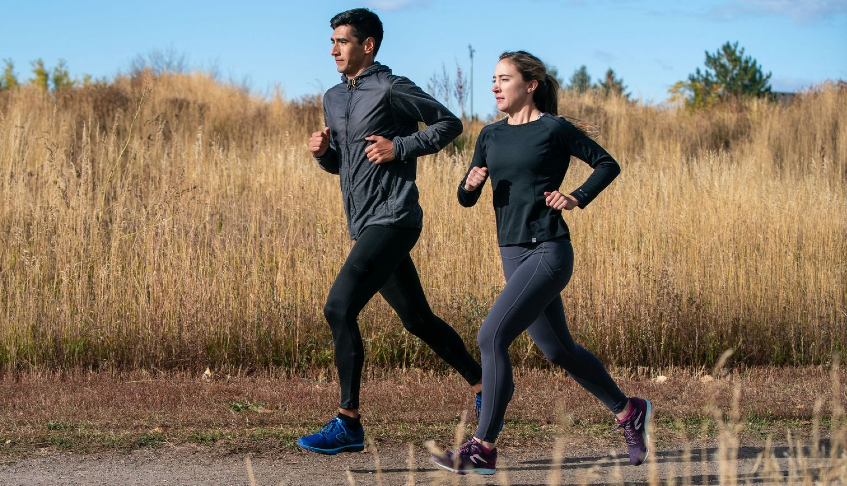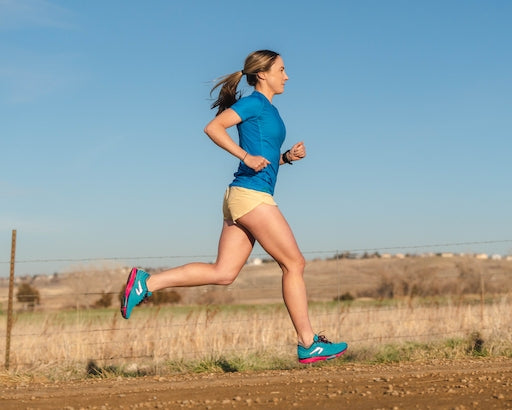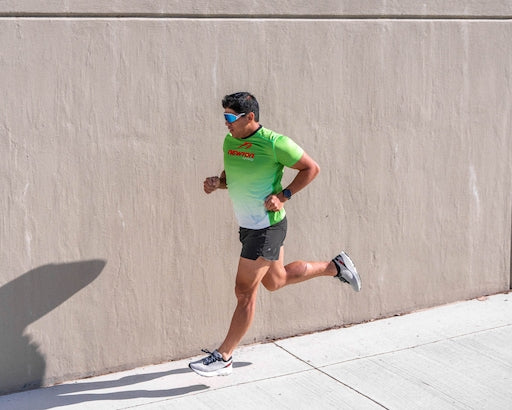
5 Tips for Improved Running Efficiency
training tips1 August 2023
By – Caitlin Alexander – PT, DPT, CAFS
Running, like any sport, requires skill, conditioning, and development. Evolution has designed our bodies for running, but our sedentary culture has rendered this skill rusty and our movement patterns impaired. Weaknesses and inefficiencies can create stress on other structures up or down the kinetic chain. This results in a suboptimal chain of power which saps performance and increases risk of injury.
Having a basic understanding of running mechanics can not only help you appreciate and improve your form, but it can also reduce chances of movement-related injuries. All athletes should be able to perform the basics when it comes to movement of their sport and with full range of motion. Anything less and they are not tapping into their full potential.
Consider a runner with a cadence of 180 steps per minute. Each foot comes into contact with the ground 90 times per minute. For a 9-minute mile, that’s 810 times - during a 5-mile run, over 4,000 times. Now imagine running 40 miles a week with a faulty gait pattern. Even a minor deviation can become amplified over time. For endurance events, inefficient mechanics really reveal themselves in the final moments of the race, when fatigue sets in and form breaks down. For these athletes, even a 3% improvement in efficiency can be a gold mine for performance.
The Gait Cycle
When analyzing running mechanics, it’s helpful to break the gait cycle into four main parts, viewing them from both the side (sagittal plane) and the front/back (frontal plane):
- Initial Contact – when the foot first makes contact with the ground
- Midstance – the moment when the foot is directly under the body’s center of mass
- Terminal Stance – the moment just before the foot pushes off the ground
- Swing Phase – the period when the foot is in the air
When running, ground reaction forces have been shown to increase 2-3 times a runner’s bodyweight. Most instances of gait deviations occur from initial contact to midstance, when the body is absorbing this load. When it comes to analyzing a runner’s form, here are five key essentials to look out for:
- Foot Strike at Initial Contact
There are three main types of foot strike – rearfoot (heel striking), midfoot and forefoot. We utilize all of these at some point on the running spectrum, but runners usually gravitate towards one. Contrary to popular belief, there is nothing inherently wrong with any of the three foot strike types. The issue arises when the foot lands far in front of the body’s center of mass, called overstriding, which applies a braking force to the body. Overstriding is often accompanied by a decreased forward trunk lean (running too upright) and a stiff knee at initial contact. This braking impulse increases the ground reaction forces up the kinetic chain and can be particularly stressful to the knees and bones of the lower leg. Runners should aim to land as close to their center of mass as possible.
- Alignment at Midstance
Midstance can tell us a lot about how well the body absorbs impact. When the body has difficulties, we often see deviations like contralateral hip drop (opposite side pelvis dropping down due to gluteus medius weakness in the stance hip), excessive compensatory lateral trunk lean, and dynamic knee valgus (the knee diving in). These findings are often directly related to hip and glute strength and poor motor control and can be cleaned up with appropriate exercise prescription.
- Hip Extension at Terminal Stance
Hip extension is one of the most important components of running gait and will vary based on running speed. When runners lack this range of motion, we see overcompensation in other areas. The heel may rise early as the foot moves behind the runner, or we may see overextension of the lumbar spine (the low back). Lack of hip extension can be remediated with specific exercises to improve mobility and flexibility in the front of the hip.
- Cadence and Vertical Oscillation
Cadence, the number of steps taken per minute (spm), is a hot topic right now. Cadence is highly individual but there are benefits to a higher step rate. A slower cadence is often associated with excessive vertical displacement, or a “bounding” style of gait. Increased vertical oscillation increases the forces acting on the body when landing and increases time spent on the ground, where most injuries occur. To put it simply, the more time you spend moving up and down, the more energy you take away from propelling the body forward. A faster cadence also shortens your stride length, making it easier to land closer to your center of mass. Optimal cadence can vary but a good, general target is between 170 and 180 spm.
- Step Width
Step width is variable from runner to runner and can depend on the runner’s speed and anatomy. A step width that is too narrow creates a “crossover gait pattern,” where the foot crosses over the midline of the body when it lands. Often times, excessive hip drop can set the foot up to land too narrowly as the leg moves through the swing phase. This places excessive stress on the outside structures of the leg and can increase the velocity of pronation at the foot. For step width, there is a sweet spot for every runner. Movement cues can help, as well as ensuring the runner has enough frontal plane hip stability to control his or her mechanics.
It’s important to remember the cyclical nature of running. Movement should be interpreted as a whole-body system of cause and effect. Every part of the gait cycle of a product of what came immediately prior to it. Understanding the basics of running biomechanics can empower you to guide an athlete in the right direction to both improve running efficiency and decrease injury risk.

TAKE A QUIZ:
- In which phase of the gait cycle do the majority of running injuries occur?
- Initial Contact
- Midstance
- Terminal Stance
- Swing Phase
- Which gait deviation during Initial Contact can lead to impact-related injuries?
- A heel-striking foot strike pattern
- A mid-foot foot strike pattern
- A forefoot foot strike pattern
- Overstriding
- Which of the following is NOT a benefit of running with a faster cadence?
- Decreased vertical oscillation
- Decreased impact forces when landing
- Increased time spent on the ground
- Increased energy efficiency
- Which of the following is a common gait abnormality seen at midstance?
- Excessive contralateral hip drop
- A stiff trunk with little or no lateral lean
- A knee in line with the toes
- Pronation at the foot and ankle
- If a runner doesn’t have adequate hip extension at the joint, what compensatory pattern might you see?
- A crossover gait pattern
- Slower than normal cadence
- Excessive arm swing
- Hyperextension of the lumbar spine
Answers: 1-(2) 2-(4) 3-(3) 4-(1) 5-(4)

